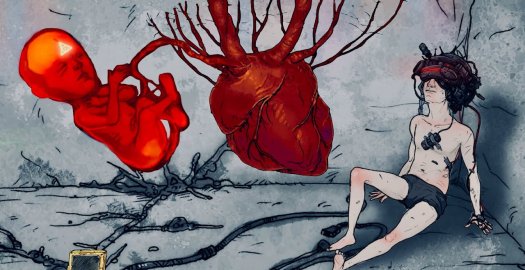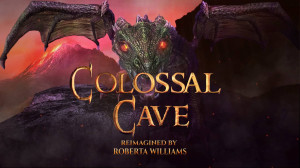Review for Magnus Positive Phototaxis

Over the course of their previous two games, the world constructed by Polish developers Sons of Welder has been defined using obscure science-fictional imagery, pictures of disembodied internal organs, and self-referential mystical philosophy. The third game in this loose series finds them in much the same mood, placing us in a now familiar setting consisting of run-down accommodation and bleak landscapes, with several puzzles to enjoy. How much will Magnus Positive Phototaxis add to what we already think we know about this difficult-to-interpret adventure game sequence?
From the outset, we are thrown into a scene of technological and mildly gruesome weirdness. Following a few short pages of an introductory monologue in which the protagonist talks about a journey and a rebirth, we find ourselves in a room with someone (is it us?) who has become so drawn into their virtual reality games console that they have somehow become mentally fused with the machine. The solution to this predicament involves tracking down a rather insectile memory stick that can perform the necessary surgery on the hapless gamer.
This gruesome puzzle serves as the introduction to the game, although the player could have been offered more help in establishing a link between this scene and later events. Along with the vaguely technological and philosophical themes found in the prequels, Magnus Positive Phototaxis incorporates a more overtly religious tone. There are symbols and images which have obviously been drawn from the world of orthodox western faiths: sinister groups of silent acolytes wearing cowls; religious books of illuminated lettering to be interpreted; paintings with apostles offering indeterminate clues to puzzles. One whole section of the game is set in a religious building of some sort, with a puzzle involving a sequence of notes on a massive church organ.
The puzzles are, as with the other Magnus games, not particularly taxing or original. In spite of the rather bizarre game setting the solutions are often quite prosaic, usually involving discovering codes and opening doors with keys found in hidden boxes. That said, the dreamlike imagery of keys, locks, and doors does all fit together quite nicely in this unreal world, and the individual solutions are satisfying enough. There was only one time when I found myself stumped, but after a short break, I came back and noticed a small cubbyhole I had previously overlooked in which I found the missing part of the puzzle.
As with the other Magnus games, what really gives this game its appeal and unique atmosphere are the curiously distorted hand-drawn graphics. This time around, there is a much richer use of colour, which adds a layer of polish missing from the earlier games. The whole thing looks very good indeed. However, I found the cutscenes -- which are stylistically distinct from the rest of the game, being carefully rendered 3D animations -- distracting and overly long. They didn’t really add anything to the experience, and in fact detracted from the slightly primitive charm of the rest of the presentation.
The wide-angle views used in some of the game’s locations lend them an illusory quality, combining the mundane with the transcendental in a disorientating way. The transitions between the different play areas seem purposely abrupt or confusing, and the player is never quite sure whether they are about to enter another dimension or just another room in the building. This unknowability of place is what generates a lot of the tension in the atmosphere as the game progresses.
Similarly, the sound effects and music add another layer of strangeness. The electronic ambient music is calming and can at times lull the player into a false sense of security -- or at other times it speaks of the technological alien-ness of the setting. Conversely, the precise and often unexpected sound effects are very well implemented and can jolt the player out of a reverie.
The point-and-click interface is straightforward, with the usual variety of pointers to indicate looking, moving or operating. Your inventory list builds up along the bottom of the screen and is cumbersome to scroll through when it gets filled up, but is at least always available to the player without impacting the play area too much. What lets down both the flow of information and the overall presentation are the object descriptions, which could be more helpful and are plastered across the screen when you mouse-over an object.
So what can we conclude about the world of Magnus from this latest installment? Well, not very much at all -- although as I have said before, logical conclusion doesn’t seem to be the point of these games. The player is invited to experience the world, to solve the puzzles and absorb the atmosphere through the graphics and the philosophical musings of the unknown protagonist. In that sense, this game is a success, as the world, the puzzles and the atmosphere work well together. They offer something unique and distinctly odd. Further to the previous two games, I found the puzzles here to be better integrated into the setting. However, there remains little in the way of a story, and the randomness of the events as they unfold might annoy some players.
Magnus Positive Phototaxis has a definite charm, as do the other Magnus games. If you are willing to overlook the deliberate obfuscation and lack of originality in the puzzle design, you can enjoy the game as a one-off, moody experience. It might be better to look elsewhere though, for a more deeply rewarding game, with challenging puzzles and the distinct flow of an easily relatable narrative with a beginning, middle, and end.























__small.jpg)



